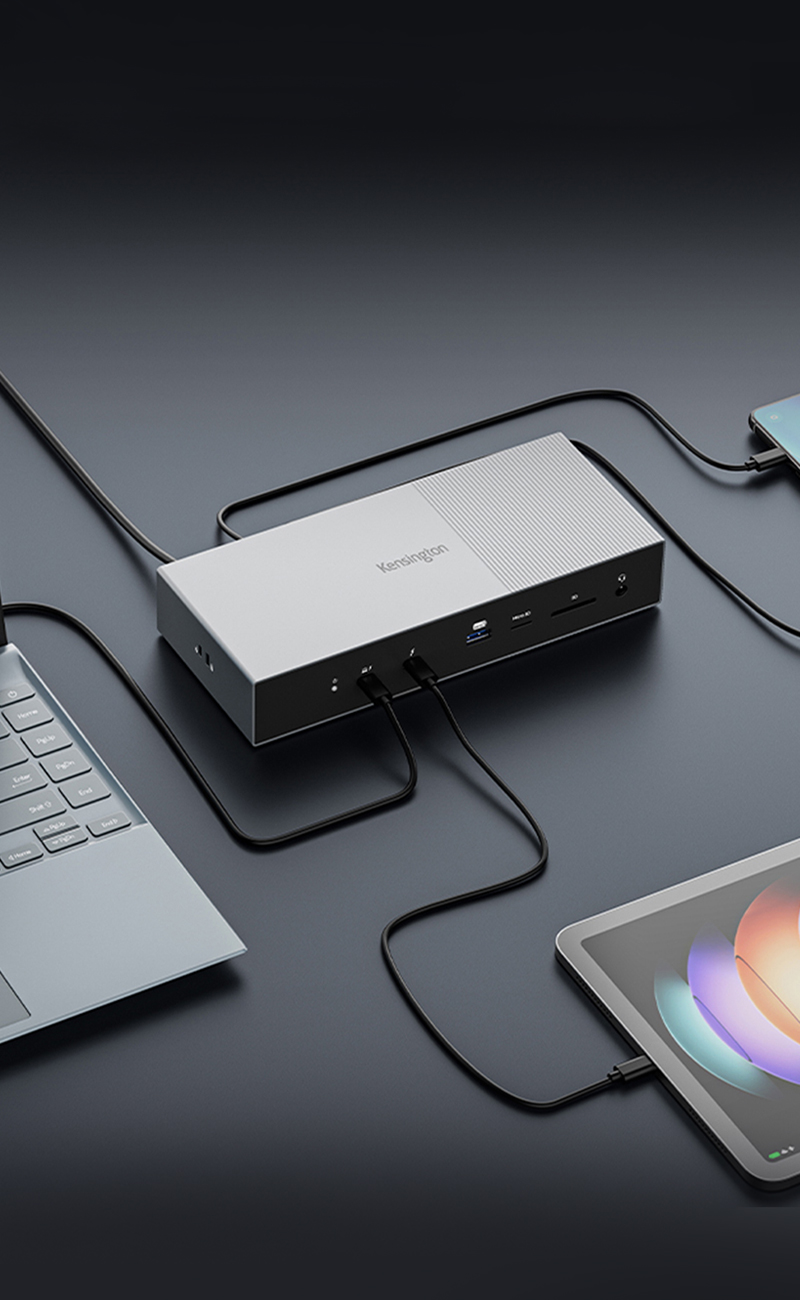Thunderbolt™ 5 Docking Station
Seamless multi-monitor setups, 80Gbps transfers, 120Gbps bandwidth boost, and 140W power delivery.
Shop Now

Seamless multi-monitor setups, 80Gbps transfers, 120Gbps bandwidth boost, and 140W power delivery.
Shop Now
Not all USB-C devices are created equal. While the new USB-C ports are very convenient, each manufacturer can set up each device model to support different levels of data, video and power. As such, compatibility with productivity accessories like the Kensington SD1500, SD4500 and SD4600P docks can vary.
USB-C is a new technology and, unfortunately, it’s also a complicated technology. Users need to ensure the accessory is compatible with their host device, and can’t assume all accessories will work seamlessly. When the host device’s USB-C capabilities are fully compatible with our docking station features, and all software on your host device has been updated, the performance should be nearly flawless.
Things to Know/Common Issues
A: To find out if your laptop is compatible with your USB-C accessory, you will need to understand the specification of the USB-C port on your laptop (This information will be available on your laptop manufacturer’s website or in the user manual that came with your laptop.)
A: No, they can be very different. USB-C contains three components:
A: USB-A supports data transmission only, while USB-C may support video, power delivery, and data. A USB-C to USB-A adapter will support data transfer, but the video and power delivery features of USB-C will not work.
A: The laptop or tablet and the USB-C accessory do a “handshake” when first connected to each other. The handshaking is a quick exchange of information on what is supported between the host device and the accessory, before everything starts to work.
A: Yes, all our USB-C devices included in the list below do not need software downloads or drivers when connecting to a host device using Windows 10 and Chrome OS (R53 or above), given that the laptop manufacturer has all the supporting features built-in to the USB-C port(s):
K33992WW – CA1000 USB-C to USB-A Adapter
K33995WW – CH1000 USB-C to 4-Port Hub
K33993WW - CV4000H USB-C to HDMI Adapter
K33994WW - CV2000V USB-C to VGA Adapter
K33969WW - SD1500 USB-C Mobile Dock
K38230WW – SD4500 USB-C Docking Station
K38231WW – SD4600P USB-C Docking Station with Power Delivery
Please note: For Windows 10 and Chrome OS (R53 or above), the docking stations are Plug & Play. The PC may start installing a driver for the peripherals attached through the dock (keyboard, mouse, etc.) during setup, but no driver is required for the dock itself.
For Mac OS, docking station users will need to install a driver for the Ethernet port. The one-time driver installation can be downloaded at software.kensington.com.
A: Yes, all our USB-C docks and adapters are compatible with laptops featuring a Thunderbolt 3 port.
Please note: The USB-C docks and adapters will not deliver Thunderbolt 3 data transfer speeds (40Gbps), only what the docking station or adapter supports (5Gbps). Also, not all Thunderbolt 3 ports support USB-C power delivery.
A: USB-C Alt Mode allows devices to deliver video signals and USB data over a single USB-C cable. There is more than one variation of Alt mode. The most popular version is DisplayPort (DP), which is the version our docks support.
To ensure that your laptop or tablet will work with our dock, please check with the laptop/tablet manufacturer to ensure that your device supports USB-C Alt mode over DP. You should be able to find this information via your device manufacturer’s website, in the user manual technical specifications, or by contacting the manufacturer directly.